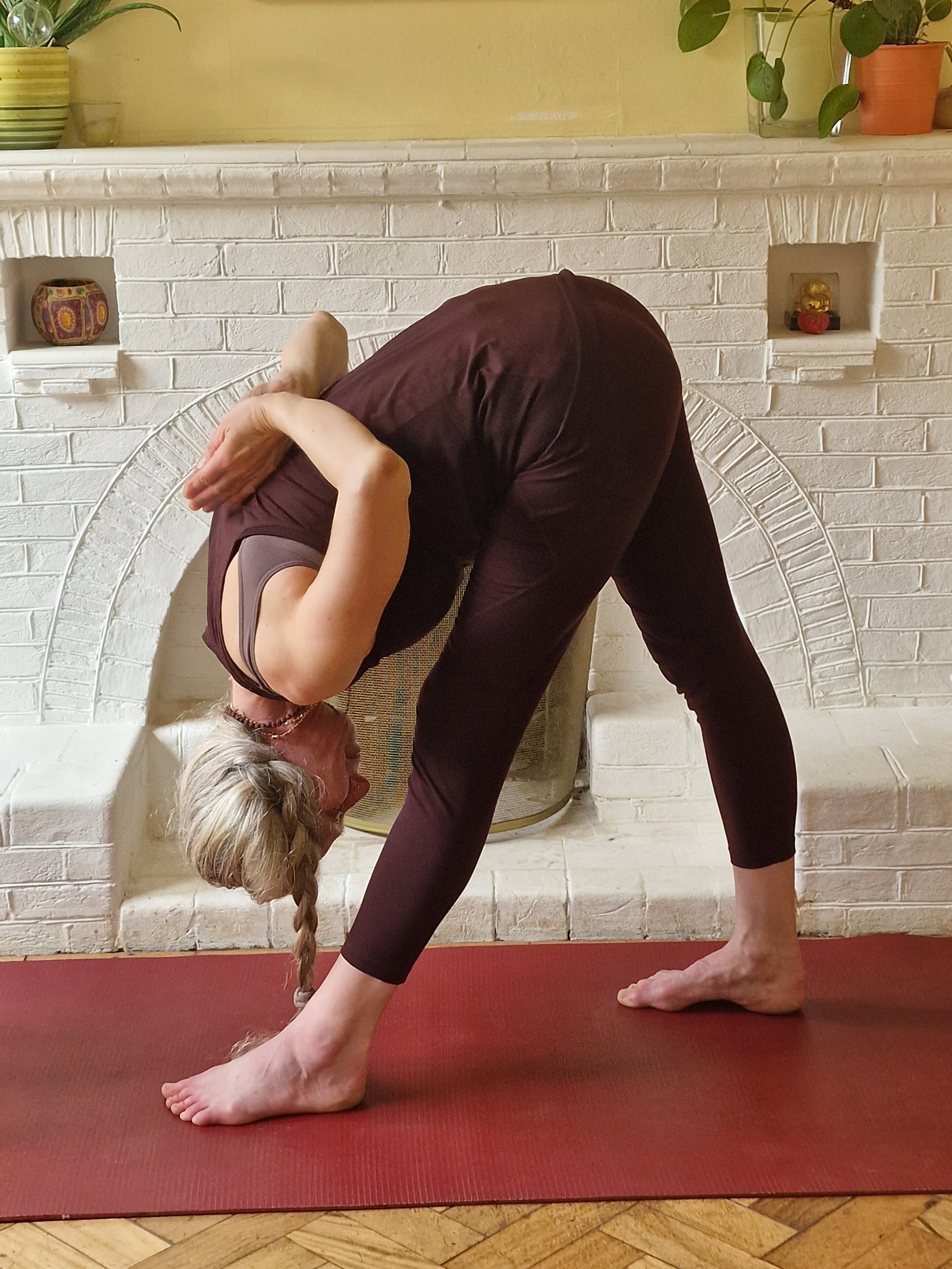Parsvottanasana – How and Why to practise it
If you like to create a sense of length through the body and calm in your mind, integrating this more taxing pose into your Yoga practice might help you.
Parsvottanasana translates as intense side stretch, and that's just what it is.
In the ashtanga Yoga standing sequence, this pose is located after Trikonasana and Parsva Konasana with their respective revolving versions and the wide-legged forward bend Prasarita Padottanasana. All prior poses prepare for this more intense stretch over the back of the legs, the back and the front of the shoulders.
If you like to create a sense of length through the body and calm in your mind, integrating this more taxing pose into your Yoga practice might help you.
Parsvottanasana translates as intense side stretch, and that's just what it is.
In the ashtanga Yoga standing sequence, this pose is located after Trikonasana and Parsva Konasana with their respective revolving versions and the wide-legged forward bend Prasarita Padottanasana. All prior poses prepare for this more intense stretch over the back of the legs, the back and the front of the shoulders.
What makes Parsvottanasana challenging?
The pose tests the following areas of our body:
the hamstrings of both legs.
the calves of the back leg.
the front of the front leg, the front of the ankle and the shin.
the length of the back, from the buttock to the neck.
the shoulders and wrists, these positions can be taxing for those joints.
For sure, it takes time and requires regular practice, patience and persistence.
How we move, or lack thereof, has changed over the last 20 years. We sit much more than previously, making our legs weaker and tighter. In addition, our shoulders are probably the stiffest as they have been in human history due to the way we are working life has developed.
All the more reasons for us to incorporate this pose into our practice.
The benefits of Parsvottanasana
I love returning to Iyengar to check in with the benefits of the different asanas. In his book 'Light on Yoga' he mentions the following effects:
Relieves stiffness in the legs and hips.
Makes hip joints and the spine more elastic.
Tones abdominal organs.
Stiffness in wrists disappears.
Corrects round and drooping shoulders.
I would add – it calms the mind as well.
All forward bends have the potential to calm our minds. We feel safer when the front of our body is protected and all our vital organs are safe, which in return contributes to managing our minds.
Equally, they can positively influence our digestion if we use the abdominal muscles to contract gently when entering and holding the pose.
How to practise Parsvottanasana?
Anatomically the pose is straightforward. However, the instructions below take you into the full pose.
From Tadasana – mountain pose
Step out into a short to middle-wide stance.
Rotate your right leg from the hip to the right about 90 degrees.
Turn the heel of your left leg slightly back.
Ensure your feet are as wide as the hips (avoid a tightrope-like position) to ensure the pelvis is level.
IN(hale) take both arms out to shoulder level.
EX(hale) rotate them in at the shoulders and lead them further back. Bend both elbows and bring the palms together behind your back.
IN lengthen through the spine and soften the knees.
EX fold forward from your hips.
IN lengthen the spine again.
EX fold further forward until the forehead or chin rests on the shin.
Stay for 5 deep breaths. Continue lengthening with each in-breath and, draw the navel gently back, draw the elbows further down.
Distribute the body's weight over both feet equally, rooting down firmly through the back heel and the entire front foot.
To exit the pose:
Use the outbreath to draw the navel back and keep it.
IN soften the knees and lift the upper body back up into standing.
EX bring both feet back to the centre.
Repeat on the other side.
What to look out for in Parsvottanasana?
As you know or can imagine, this deep forward bend can bear certain risks.
For example, we can exert excessive pressure on the front knee if the weight is not evenly distributed and we are not engaging the abdominal muscles.
In case of lower back issues, deep forward bends need to be avoided, and one of the earlier stages is safer.
As mentioned above, deep forward bends can be tricky for lower backs where there are issues present. The lower back is in a precarious position, carrying the upper body's weight. When the intervertebral disk is thinning, and the cushioning for the nerves get less, the nerves get under pressure during forward bends. Always emphasise length when folding forward.
The area is the shoulders. In this particular position here, reverse anjalee mudra, the shoulders joints need mobility to be comfortable, especially as the elbows and wrists are bent.
So always find a version that suits you.
How to make Parsvottanasana easier?
There are several to make this happen. Here are a few ideas:
Legs:
Keep the knees bent or the upper body higher to reduce the stretch over the back of the legs.
Lower back:
Place hands on the wall or a chair/table to keep the upper body parallel to the floor.
Shoulders:
Place hands on the waist.
Interlace fingers behind your back, and keep your arms straight.
Hold the opposite elbow.
There is something for everyone, whatever the capabilities of the body are. Parsvottanasana is a great pose with many benefits for both the body and the mind.
Whatever we practise, we need to be mindful, listen to what our body has to say, and be patient, waiting for the muscles to release and the body to go deeper into the pose.
There are benefits at every stage to enjoy.
Learn more about practising Yoga asanas in any of our sessions.

